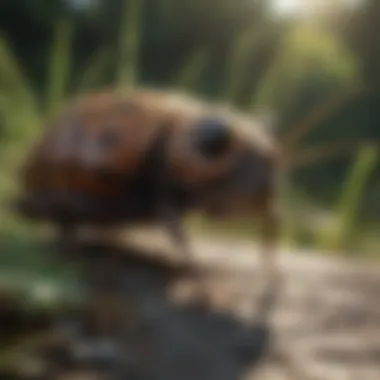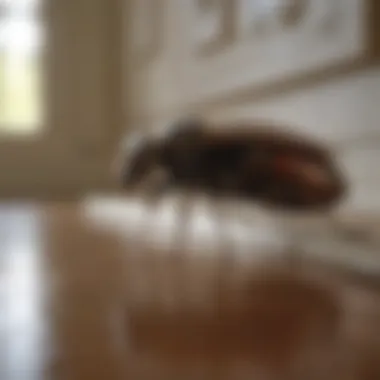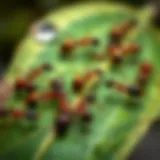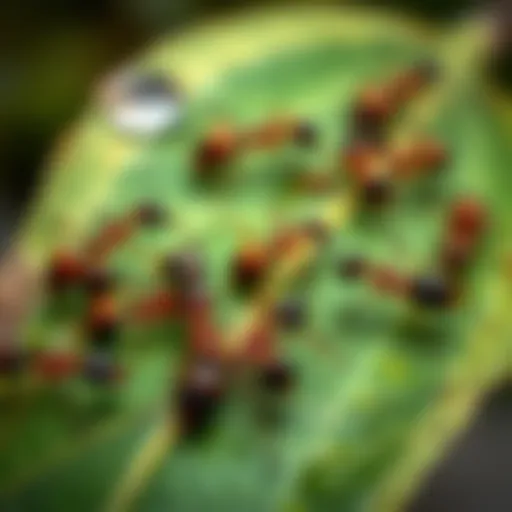Pest Control in Ellijay, GA: A Comprehensive Guide


Intro
In Ellijay, Georgia, the lure of nature's beauty brings with it various pests that can be a nuisance in homes and businesses. Understanding the local pest population is key to ensuring a safe and comfortable environment. This guide will provide insights into the unique challenges posed by pests in this region, the importance of eco-friendly practices, and useful strategies for effective pest management.
Understanding the Pest
Identification
Identifying pests accurately is the first step toward effective control. Common pests in Ellijay include ants, termites, roaches, and various rodents. Each of these pests has distinct characteristics that help in their identification. For example, carpenter ants are known for their large size and black or reddish coloration, while termite swarms typically occur in the spring. Observing these traits can aid homeowners in distinguishing among species and deciding the best action.
Life Cycle
Understanding the life cycle of these pests is also crucial. Most insects, like ants and roaches, undergo metamorphosis, involving egg, larval, pupal, and adult stages. For instance, a termite's life starts from an egg that hatches into a nymph, which matures into an adult. This knowledge is valuable as it helps in timing pest control measures. Targeting pests at the right life cycle stage can increase the effectiveness of treatments.
Pest Prevention Strategies
Environment Modification
To prevent pests, modifications in the environment may be necessary. This includes sealing cracks and gaps in buildings to block entry points. Keeping gardens well-maintained is also essential, as overgrown vegetation can attract unwanted pests. Additionally, homeowners should ensure that food sources are properly stored and garbage is disposed of regularly to reduce attraction.
Physical Barriers
Physical barriers can also deter pest intrusion. Simple solutions such as screens on windows and doors or mesh around vents effectively block pests. Installing door sweeps can prevent rodents from finding their way into homes. These measures are practical, cost-effective, and contribute to maintaining a pest-free environment.
Control Methods
Chemical Control
When prevention strategies fall short, chemical control may be necessary. There are various pesticides available, and products like Ortho Home Defense are popular for indoor use against roaches and ants. However, it is crucial to follow label instructions to ensure safety. Understanding the potential impacts of chemicals on family and pets is also important.
Biological Control
Biological control methods are gaining traction, emphasizing natural pest management. Beneficial insects like ladybugs can help control aphid populations. Additionally, certain natural pesticides, such as those derived from neem oil, are effective against various pests without causing harm to the environment. Use of these methods supports sustainable pest management practices.
"Effective pest management balances between controlling pests and protecting the environment for future generations."
Prelims to Pest Control in Ellijay
Pest control is a vital concern for residents in Ellijay, Georgia. The uniqueness of local fauna and the region's rich biodiversity brings about a variety of pest-related challenges. Understanding this topic ensures that homeowners are well-equipped to manage pests effectively. Effective pest management not only protects properties but also contributes to a healthier environment.
Understanding the Local Ecosystem
Ellijay features a diverse ecosystem influenced by its geographical location in the Blue Ridge Mountains. This unique environment supports numerous species of flora and fauna. However, this biodiversity also means that it can harbor various pests that may invade homes and gardens. Pests such as ants, termites, and various beetles are commonly encountered. A familiarity with these local species aids in both identification and management.
Residents need to appreciate the role that local ecosystems play in pest migration and infestation patterns. For instance, understanding seasonal changes can help predict when certain pests are most likely to appear. It is essential to recognize that not all insects are harmful; some play beneficial roles in gardens and natural pest control.
In addition to insects, moisture levels and vegetation also influence pest populations. For example, areas with standing water can attract mosquitoes. Thus, maintaining a clean environment is pivotal for reducing pest activity. Regularly monitoring the surroundings and understanding ecosystem dynamics can lead to more effective and sustainable pest management strategies.
Importance of Effective Pest Management
Effective pest management is crucial for maintaining a safe and healthy living space in Ellijay. Pests can not only cause damage to properties but may also pose health risks. Infestations can lead to structural damage, particularly with wood-destroying insects like termites. This damage can result in costly repairs and compromise the structural integrity of homes.
Moreover, the presence of pests may lead to allergies and other health issues among household members. Certain pests, like cockroaches and rodents, are known carriers of diseases. Therefore, addressing pest issues should be a priority for homeowners.
Implementing effective pest management practices can benefit both the homeowner and the community. It reduces the reliance on chemical pesticides, promoting a healthier ecosystem. Furthermore, educating oneself about pest behavior and management strategies can empower residents. This knowledge can lead to informed decisions, minimizing harm to the environment while protecting personal spaces.
"An informed homeowner is the first line of defense against pest infestations."
Finally, a proactive approach to pest control fosters a greater sense of community. When residents are vigilant and proactive about pest management, it collective improves the overall quality of life in Ellijay. These efforts can lead to fewer pest-related issues in the area, benefiting all residents.
Common Pests in Ellijay
Understanding common pests in Ellijay is crucial for effective pest management. Each type of pest presents unique challenges and impacts the local environment differently. Homeowners should be aware of the identification, behavior, and potential risks associated with these pests. This knowledge allows for timely intervention, which can prevent infestations from escalating into more serious issues.
Identifying Household Pests
Household pests can disrupt daily life and cause damage to properties. Identifying these pests early is essential for implementing effective control methods.
Ants


Ants are social insects that often invade homes in search of food and shelter. They are known for their ability to communicate and work together in large colonies. The most common species in Ellijay includes the Carpenter Ant and the Fire Ant. Carpenter Ants can cause significant structural damage, while Fire Ants can be notably aggressive. Their ease of access into homes makes them a popular topic for pest control discussions in this article.
The key characteristic of ants is their colony structure, which allows them to establish large populations quickly. One advantage of addressing ant infestations promptly is that it prevents their colony from growing. However, they can also pose a challenge due to their constant search for food, making effective removal necessary.
Termites
Termites are wood-destroying insects that can severely damage the foundation of structures. They thrive in the warm, humid climates found in Ellijay. The Subterranean Termite is particularly prevalent, which creates colonies underground and can quickly invade wooden structures.
The key characteristic of termites is their ability to consume wood continuously. This makes them a significant concern for homeowners. By identifying signs of termite activity early—such as discarded wings or hollow-sounding wood—homeowners can take swift action to mitigate the damage. However, treating termite infestations often requires professional assistance, which can add to the overall cost of pest management.
Roaches
Roaches are notorious for their resilience and ability to adapt to various environments. In Ellijay, the American Cockroach and German Cockroach are common. They are often found in warm, dark places, such as kitchens and bathrooms.
What sets roaches apart is their rapid reproduction rate. This characteristic means that a small problem can quickly turn into a larger infestation. While their presence raises health concerns, especially due to disease transmission, there are also effective methods of control. Maintaining cleanliness can help reduce their attraction to homes, making prevention an essential focus of pest management.
Outdoor Pests Impacting Gardens
Pests affect not only inside the home but also outside in gardens. Homeowners with gardens in Ellijay must be vigilant regarding outdoor pests as they can threaten plant health and productivity.
Beetles
Beetles, such as the Japanese Beetle, can severely damage garden plants by feeding on their leaves and flowers. They often appear in large numbers, making them noticeable nuisances during the growing season.
The main characteristic of beetles is their tough exoskeleton and distinctive chewing mouthparts. Their attractiveness to garden plants makes them a focus in pest discussions. While they can be difficult to control due to their rapid reproduction and ability to fly, utilizing traps and targeted insecticides can be effective strategies.
Lepidopteran Larvae
The larvae of moths and butterflies can cause significant feasting on crops and flowers, leading to considerable damage. These larvae, often referred to as caterpillars, vary in species but commonly include the Tobacco Hornworm and various cutworms.
One key aspect of these larvae is their often voracious appetite, leading to rapid defoliation of plants. Effective control requires careful monitoring and can involve both natural predators, like birds, and organic pesticides. However, balancing these methods is important to maintain a healthy ecosystem in the garden.
Nematodes
Nematodes are microscopic roundworms that can infest the soil and affect the roots of plants, leading to poor growth. Some nematodes are beneficial, while others—such as root-knot nematodes—are harmful and create significant damage.
A significant characteristic of nematodes is their nearly invisible nature, making them challenging to detect until damage occurs. Understanding their role in the garden helps homeowners select appropriate pest control methods. Using nematodes for pest management can also turn back the infestation without harming beneficial species in the garden.
In summary, identifying and managing common pests in Ellijay is a key aspect of maintaining both homes and gardens. Awareness of these pests assists homeowners in taking preventive measures and addressing issues effectively.
Biology and Behavior of Common Pests
Understanding the biology and behavior of common pests in Ellijay is vital for effective pest control strategies. Knowing how pests develop, what habitats they prefer, and their feeding habits can help homeowners and pest control professionals make informed decisions. This section delves into these aspects and highlights the significance of comprehending pest behavior.
Life Cycles of Common Pests
The life cycle of pests includes distinct stages that vary between species. For example, ants undergo a complete metamorphosis with four stages: egg, larva, pupa, and adult. On the other hand, termites have a similar life cycle where they mature through nymph stages before becoming adults. Understanding these stages is crucial for effective management. For instance, targeting larval stages with specific treatments can be more effective than treating adult insects.
Pests can reproduce quickly, which complicates management efforts. Their various life stages present different vulnerabilities and require tailored interventions. A proactive approach that focuses on disrupt this cycle can greatly reduce pest populations over time.
In addition, some pests remain dormant during unfavorable conditions, making it necessary to monitor environments continuously. Recognizing these life cycles can help in anticipating pest outbreaks and implementing control measures before infestations become severe.
Habitat Preferences and Feeding Habits
Each pest species has unique habitat preferences based on factors like moisture level, shelter, and food availability. For instance, cockroaches prefer dark, humid areas, often found in kitchens and bathrooms. In contrast, termites require wood and cellulose materials, which are commonly found in homes or gardens.
Their feeding habits also play a crucial role in infestation severity.
- Ants often forage in groups, making them highly efficient at locating food sources.
- Termites consume wood continuously, often causing significant structural damage before detection.
- Roaches not only eat food but also contaminate it, posing health risks.
Understanding these behaviors allows for better prevention strategies. Homeowners can create environments less conducive to pest habitation by eliminating food sources and breeding sites. This proactive maintenance reduces the likelihood of infestations.
"Recognizing and adjusting to pest behaviors ensures effective pest management strategies are in place, reducing long-term damage and health risks."
By focusing on the life cycles and habitat needs of common pests, homeowners in Ellijay can implement targeted, effective pest control measures, creating a healthier home environment.
Pest Control Strategies
Pest control strategies are essential for managing pest populations effectively and sustainably, especially in regions like Ellijay, Georgia. This section will explore various methods ranging from traditional approaches to eco-friendly solutions and integrated pest management practices. Understanding these strategies allows homeowners to make informed decisions that benefit both their property and local ecology.
Traditional Pest Control Methods


Chemical Sprays
Chemical sprays have long been a common method for managing pest issues. These sprays deliver potent chemicals directly to target pests, making them a powerful tool in any pest management arsenal. One key characteristic of chemical sprays is their ability to provide immediate results. This is particularly beneficial for urgent infestations that require swift action.
However, while effective, chemical sprays come with their own set of concerns. Their use can lead to unintended harm to non-target insects and environmental damage. Therefore, while they offer a quick fix, it is essential to consider this method's long-term implications on local ecosystems. Certain chemical pesticides, if mismanaged, may also present health risks to humans and pets.
Baits and Traps
Baits and traps are another traditional method for controlling pest populations. These devices lure pests into them using attractants and can be particularly effective for specific species, such as rodents and cockroaches. One key characteristics of baits and traps is that they are generally safer for other non-target species compared to chemical sprays. They target specific pests without widespread chemical application.
The unique feature of baits is their dual function: they can eliminate pests on contact or through ingestion. However, this method requires consistent monitoring and maintenance to ensure effectiveness. It may also take longer to see a reduction in pest populations, making it less ideal for immediate infestations. Nevertheless, when integrated into a broader pest management strategy, baits and traps can be highly effective.
Eco-Friendly Approaches
Natural Predators
Utilizing natural predators is an increasingly popular eco-friendly pest management strategy. By introducing or encouraging beneficial species like ladybugs and certain birds, homeowners can keep pest populations in check naturally. This method's key characteristic is that it works within the existing ecosystem, maintaining the balance and reducing the need for chemical interventions.
The unique feature of using natural predators is that they can offer a sustainable solution to pest issues. However, there is a need for careful consideration of the introduced species' impact on the local habitat. While natural predators can be highly effective, their success depends on adequate food supply and habitat conditions.
Organic Pesticides
Organic pesticides offer an alternative to traditional chemical methods. These products often use naturally derived ingredients, making them a safer option for households with children and pets. One of the strong traits of organic pesticides is their lower environmental impact. These products can break down more easily in the ecosystem, reducing potential harm.
Their unique feature includes a wider application range, as some organic options target specific pests while being safe for non-target species. However, organic pesticides may not always provide immediate results compared to synthetic alternatives and could require repeated applications to achieve desired effects.
Physical Barriers
Physical barriers are a preventive strategy often overlooked in pest control. This method involves using materials such as screens, nets, or fine mesh to keep pests out of homes and gardens. The key characteristic of physical barriers is their simplicity and effectiveness in creating a barrier against invasive species.
A unique feature includes the diverse materials that can be employed, ranging from netting to specialized plant coverings. However, while easy to implement, physical barriers require regular maintenance to ensure they remain effective. They also may not work for all types of pests, particularly those that can find their way inside through small gaps.
Integrated Pest Management (IPM)
Integrated Pest Management, or IPM, is a comprehensive approach that combines various pest control strategies tailored to specific pest challenges in Ellijay. This method is crucial as it allows for the careful evaluation of pest issues, promoting a balance between effective control and environmental stewardship. IPM emphasizes monitoring and understanding pest biology and behavior, resulting in more targeted treatments.
IPM strategies can include regular inspections, habitat modification, and the use of biological controls alongside traditional methods. These elements create a holistic approach that considers the interplay of various pest management options. Furthermore, IPM can significantly reduce reliance on chemical pesticides, making it a healthier choice for both residents and their surroundings.
Professional Pest Control Services in Ellijay
In Ellijay, the pest control landscape is essential for maintaining not only homes but also the overall quality of life. Professional pest control services offer a structured approach to dealing with pest issues. Many homeowners often express uncertainty about whether to tackle pest problems on their own or to seek expert help. This section aims to clarify such concerns. The advantages of engaging professional services are noteworthy. They provide specialized knowledge and tools, which can effectively mitigate pest infestations in ways that DIY solutions may not.
Choosing the Right Service Provider
When selecting a pest control service in Ellijay, several factors should be considered to ensure optimal results. First, it is crucial to check for licensing and certification. Reputable pest control companies normally hold the necessary permits to operate within Georgia. This compliance with state regulations provides assurance of the service provider's credibility. Secondly, evaluating the range of services offered can be beneficial. Some companies specialize in specific areas, like termite control, while others offer comprehensive pest management solutions.
Moreover, customer reviews play a significant role in choosing the right provider. Look for testimonials on the company’s website or on platforms like Reddit. This feedback can provide insights into the effectiveness of their services. Lastly, transparency in pricing is essential; a trustworthy company will provide clear and detailed estimates without hidden fees.
Evaluating Pest Control Companies
After narrowing down potential service providers, it is important to conduct a thorough evaluation. One significant aspect to consider is the experience of the company. Companies with years of operation typically have encountered a variety of pest issues, which equips them with valuable knowledge. Also, inquire about their pest management techniques. Are they using eco-friendly methods, or do they rely on chemical sprays? This is vital for ensuring that the chosen pest control methods align with personal preferences regarding safety and environmental care.
Furthermore, it can be beneficial to ask about the follow-up procedures post-treatment. A good pest control company will not only address the current infestation but also provide preventive strategies to avoid future issues. This can include routine inspections or recommendations for home maintenance.
Legal Considerations for Pest Control
Understanding the legal aspects surrounding pest control is essential for both homeowners and professionals in Ellijay. This section elucidates the relevant regulations and requirements that come into play in pest management. These legal considerations not only protect the public but also help ensure that pest control practices are performed safely and effectively.
The legal framework for pest control in Georgia is designed to provide a structured approach to pest management. Compliance with these regulations is crucial for maintaining environmental safety and public health. Failing to adhere to local laws can lead to severe consequences, including fines or legal actions.
State Regulations in Georgia
In Georgia, pest control is governed by specific state regulations that apply to various aspects of pest management. These laws help oversee the use of pesticides, the qualifications needed for pest control businesses, and the overall safety of the practices involved. Regulatory compliance ensures that the pest control methods employed do not harm the environment or human health.
Some key regulations include:
- Pesticide use restrictions: Certain pesticides may be restricted or require special permits for use.
- Notification requirements: Homeowners must often be informed about the pesticides being applied and any associated risks.
- Environmental protections: Regulations are in place to protect local wildlife and water sources from hazardous substances. This is particularly relevant in Ellijay where natural habitats are prevalent.
It is advisable for homeowners to familiarize themselves with both state and local pest control laws. This knowledge can guide effective pest management strategies while promoting safe practices.


Licensing Requirements for Pest Control Professionals
Licensing is a critical component for pest control professionals in Georgia. The state mandates that individuals and companies engaged in pest management must obtain the appropriate licenses. This requirement exists for several reasons.
- Safety Assurance: Licensed professionals have undergone training to understand the proper use of pesticides and methods, minimizing risks to the public.
- Standards Compliance: Licensed operators must adhere to state standards, ensuring ethical and effective pest control.
- Accountability: Licensing facilitates accountability in the industry. Unlicensed practices can result in ineffective pest management and environmental harm.
To obtain a pest control license in Georgia, individuals must pass a certification exam administered by the Georgia Department of Agriculture. This exam tests knowledge of pest biology, pesticide application, and legal responsibilities. Hence, professional pest control services in Ellijay should only be contracted if they can provide proof of their licensing.
Preventative Measures for Home and Garden
Preventative measures play a crucial part in effective pest control strategies. This section details several approaches to reduce the likelihood of pest infestations both in homes and gardens. Effective prevention can lead to a safer and more comfortable environment, while also conserving resources and minimizing the need for chemical pest control solutions.
Routine Maintenance Practices
Regular maintenance is key for pest prevention. Homeowners should focus on several core activities to maintain their property effectively:
- Regular Cleaning: This includes sweeping, vacuuming, and wiping down surfaces to remove crumbs and spills that can attract pests.
- Proper Waste Management: Safely sealing garbage and ensuring it is removed regularly can deter pests from scavenging.
- Inspections: Conducting routine checks for signs of pests or damage can help catch issues early.
- Sealing Entry Points: Gaps in walls, doors, and windows should be sealed with caulk or weather stripping. This eliminates easy access for pests.
- Yard Maintenance: Keeping yards tidy, trimming overgrown shrubbery, and removing debris can help limit pests that thrive in chaotic environments.
Implementing these practices not only keeps homes clean but also creates an uninviting atmosphere for pests.
Creating an Insect-Resistant Home
Designing your home with pest resistance in mind is a proactive strategy. Here are some effective methods:
- Use Screens: Installing screens on windows and doors allows for fresh air circulation while keeping unwanted insects outside.
- Choose Resistant Materials: When possible, select construction materials specifically designed to resist pests, such as treated wood for outdoor structures.
- Landscaping Choices: Opt for plants known to repel pests. For example, lavender and marigolds can deter certain insects naturally.
- Proper Drainage: Ensure that water drains away from the foundation to prevent moisture problems, which attract termites and mosquitoes.
- Check for Dampness: Inspect areas like basements and crawl spaces regularly for moisture, which creates ideal breeding grounds for pests like roaches and mold.
By adopting these preventative measures, you will create an environment that significantly reduces the inlet for pest populations, safeguarding your home and garden.
Incorporating a culture of prevention can alleviate pest pressure. Homeowners who prioritize these practices are likely to enjoy a more peaceful living space and a thriving garden.
The Role of Community in Pest Management
Effective pest management is not solely the responsibility of individual homeowners or pest control companies. The role of community in pest management is significant, especially in places like Ellijay, Georgia, where residential areas often intertwine with natural ecosystems. Community engagement can enhance pest control efforts through shared knowledge, resources, and responsibility.
Communities that work together can identify pest problems early. They can coordinate efforts to address issues, reducing the overall pest population. Such collaboration can also mitigate the environmental impact of pest control measures. When neighbors understand the shared risks of pest infestations, they are more likely to adopt preventative measures and support local regulations aimed at pest management.
By fostering a proactive community approach, residents can promote a healthier and more sustainable environment. Information dissemination plays a key role in this regard. Educational initiatives can alert homeowners to common pests, signs of infestation, and methods for prevention. Awareness can lead to a collective commitment to maintaining property standards and implementing appropriate pest control measures.
Community Awareness Programs
Community awareness programs are essential for fostering engagement in pest management. These programs can be organized by local governments, pest control services, or community organizations. They often include workshops, informational sessions, and informational pamphlets. The objective is to inform residents about the types of pests common in Ellijay and the best practices for preventing infestations.
Such programs can offer benefits like:
- Educational workshops: Hands-on learning about pest identification and control strategies.
- Resource dissemination: Providing pamphlets and guides on pest management.
- Interactive events: Community fairs that include demonstrations of pest control methods and eco-friendly practices.
A successful program might encompass projects in schools, where students learn pest ecology, thereby encouraging families to engage at home. This promotes a culture of awareness and preparedness around the issue, ultimately leading to healthier homes and gardens.
Sharing Best Practices
Sharing best practices is vital for enhancing collective pest control efforts. When neighbors communicate about what works and what does not, they build a repository of knowledge that benefits everyone. This can occur through formal meetings, neighborhood apps, or social media groups.
Some best practices to consider include:
- Regular inspections: Homeowners can share schedules and methods for regular property checks.
- Eco-friendly solutions: Community members can discuss and promote the use of organic pest control methods, reducing chemical exposure.
- Collaborative pest control: Neighbors may coordinate treatments for shared spaces, like gardens or parks, reducing the overall pest population in the area.
Communities that actively share this knowledge often see a decrease in pest-related issues. In Ellijay, adopting these practices can significantly enhance the effectiveness of pest management and create a more united approach to preserving the local environment. Together, homeowners can cultivate safe and thriving habitats that deter pests sustainably.
The End
Effective pest control in Ellijay is more than just a response to an infestation; it embodies a proactive approach to maintaining a healthy living environment. This article underscores crucial elements related to pest management, including the identification of common pests, their biological behaviors, and effective strategies for their control.
By summarizing key points, homeowners should now recognize the necessity of regular monitoring and maintenance practices, as well as eco-friendly solutions that balance efficacy with environmental considerations. These methods not only help in managing existing pest problems but also prevent future infestations. Understanding local regulations and avenues for professional pest control services further emphasizes the importance of a well-rounded pest management plan for both household and garden initiatives.
"Ongoing education and community participation are vital for effective pest management."
Summary of Key Points
- Local Ecosystem Awareness: Knowledge about the local ecosystem aids in identifying specific pest threats.
- Common Pests: Awareness of household and outdoor pests helps in timely intervention.
- Management Strategies: Variety of both traditional and eco-friendly pest control methods enables tailored approaches to different situations.
- Professional Services: Leveraging local expertise ensures comprehensive pest management, aligning with both needs and regulations.
- Community Efforts: Engaging in community programs fosters a collaborative environment for efficiency in pest control practices.
Looking Ahead: Future of Pest Management in Ellijay
The future of pest management in Ellijay will likely revolve around a stronger emphasis on ecological responsibility. As awareness of environmental issues increases, homeowners are turning towards more sustainable practices that integrate technology and education. Innovations in pest control technologies, like smart traps and tracking systems, will become more common.
The role of community efforts can't be understated. There is significant potential for enhanced cooperation among residents to share information and strategies. Local workshops that focus on organic pest control methods can elevate the standard for managing infestations while also encouraging mindfulness regarding the ecological footprint of pest control methods.
In summary, the path forward looks promising. By remaining engaged, educated, and proactive, homeowners in Ellijay can navigate their pest control dilemmas with informed precision.







